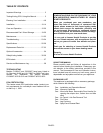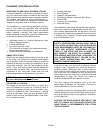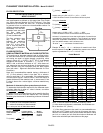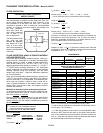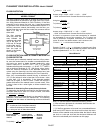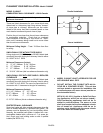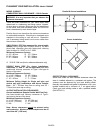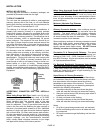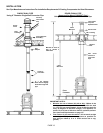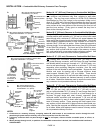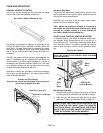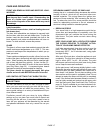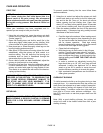
INSTALLATION
PAGE 11
CHIMNEY INSPECTION
Existing chimneys must be inspected before installing
your stove. Consult your local building department for
chimney code requirements. A masonry chimney must
have a code approved liner. This liner must not have
broken or missing pieces. Some non-code masonry
chimneys may be brought up to code by being relined.
(Consult your dealer or qualified chimney sweep).
Factory-built chimneys should also be inspected, first
for creosote deposits (which should be removed), and
then for integrity of the stainless steel liner. Look for
obvious bulges in the lining, which may indicate the
need to replace that section (use a bright flashlight).
Also, inspect the attic to see that the chimney has
proper clearance to combustible framing members. For
interior masonry chimneys and most factory-built chim-
neys, this must be a (2) two inch air space clearance,
which must not be filled with insulation or any other
material. An exterior masonry chimney must have a (1)
one-inch air space clearance.
CHIMNEY HEIGHT REQUIREMENTS
The chimney must extend 3 feet above the level of roof
penetration and a minimum of 2 feet higher than any
roof surface within 10 feet (see below). Check with
your local building officials for any additional require-
ments for your area.
Due to prevailing winds, local terrain, adjacent tall
trees, a hill, or ravine near the home, or adjacent struc-
tures, additional chimney height or a special chimney
cap may be required to ensure optimum performance.
The 10’ by 2’ Rule for Vent Termination
The top of the flue must be 2’ (610 mm) higher than
any part of the roof within 10’ (305 cm) horizontal and a
minimum of 3’ (915 mm) higher than the highest point of roof
penetration.
SPECIAL NOTE:
The installation of a barometric damper is recommended
for all freestanding stoves in areas that may have high
winds, which can effect the draft. The installation must be
only in units with a newly constructed chimney, free of
creosote deposits. The barometric damper is an automatic
device designed to regulate the draft in a heating appli-
ance, which in turn, stabilizes the chimney temperatures,
lessening the potential of over-firing. Do not place the
barometric damper greater than 24 inches (610 mm) above
the unit. Excessive draft will lead to poor control of the
burning rate and possible over-firing of the stove and dam-
age to the cast iron firebox. Most barometric dampers are
calibrated in inches of water column and can be set to draft
requirements of -.03 to -.08 inches (-7.5 to -20 Pa). It is
recommended that the barometric dampers to be set be-
tween -.05 and -.06 inches.
THE RECOMMENDED DRAFT REQUIREMENTS FOR
THESE APPLIANCES IS NO LESS THAN -.05 AND NO
GREATER THAN -.06. OPERATION OF YOUR STOVE
WITH A DRAFT GREATER THAN -.06 CAN POSSIBLY
CAUSE DAMAGE TO THE STOVE AND VOID THE
WARRANTY.
Fire intensity is a function of several factors. One of these
factors is DRAFT. Normally, increasing draft increases fire
intensity. Conversely, increasing the fire intensity will in-
crease draft. Draft can also be affected by external factors
such as wind strength and direction, outside temperature,
airflow in or out of the structure, and so forth. If one of
these factors changes, the draft of a low-burning appliance
may increase. This increased draft may cause danger-
ously high temperature to develop, possibly causing failure
of the unit or flue, or ignition of nearby combustibles. Clos-
ing down the combustion airflow ("Primary Air Draft Con-
trol") may not guarantee that this will not happen.
CAUTION: MANY STRUCTURE FIRES HAVE RE-
SULTED WHEN A SLOW BURNING FIRE HAS BEEN
LEFT UNATTENDED FOR ANY EXTENDED PERIOD OF
TIME. THESE FIRES NORMALLY OCCUR BECAUSE
COMBUSTIBLE MATERIALS CLOSE TO AN APPLI-
ANCE BECOME HEATED TO THE IGNITION POINT BY
AN OVERFIRED APPLIANCE WHICH THE OPERATOR
THOUGHT WAS SAFETY "THROTTLED DOWN."
Requires A Listed
Termination Cap
2’ (610mm)
10’ (305 cm)
3’ (915mm)



